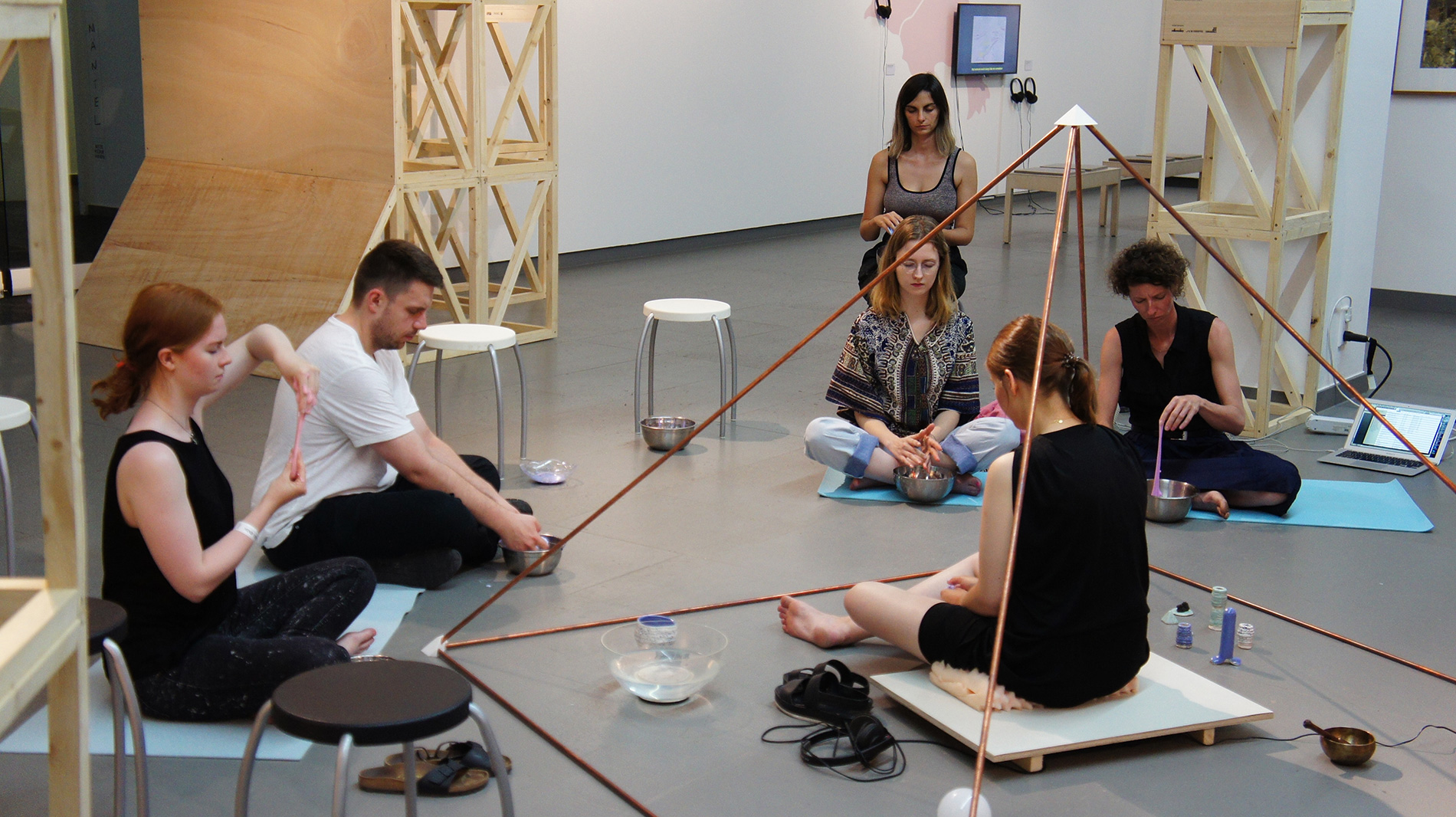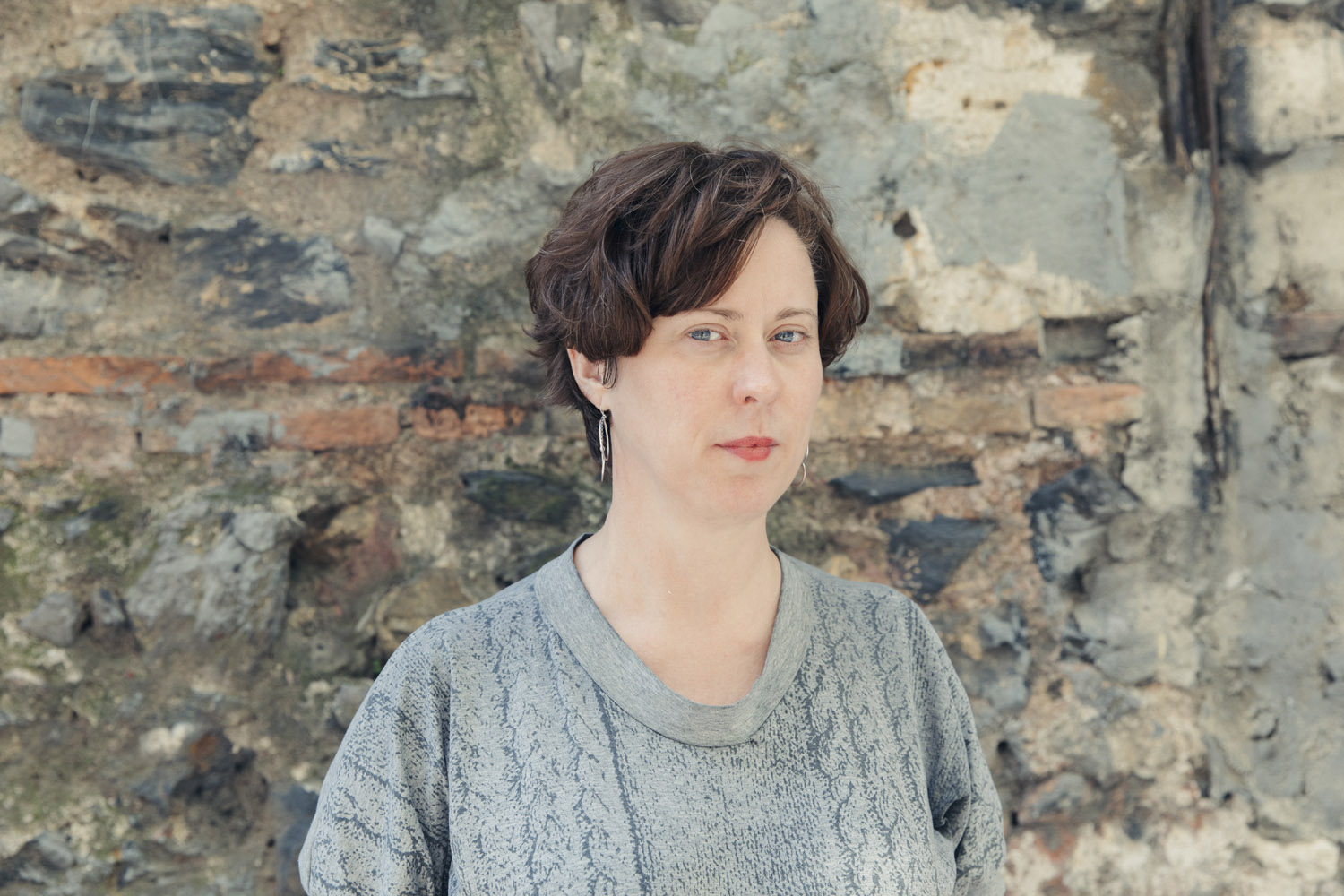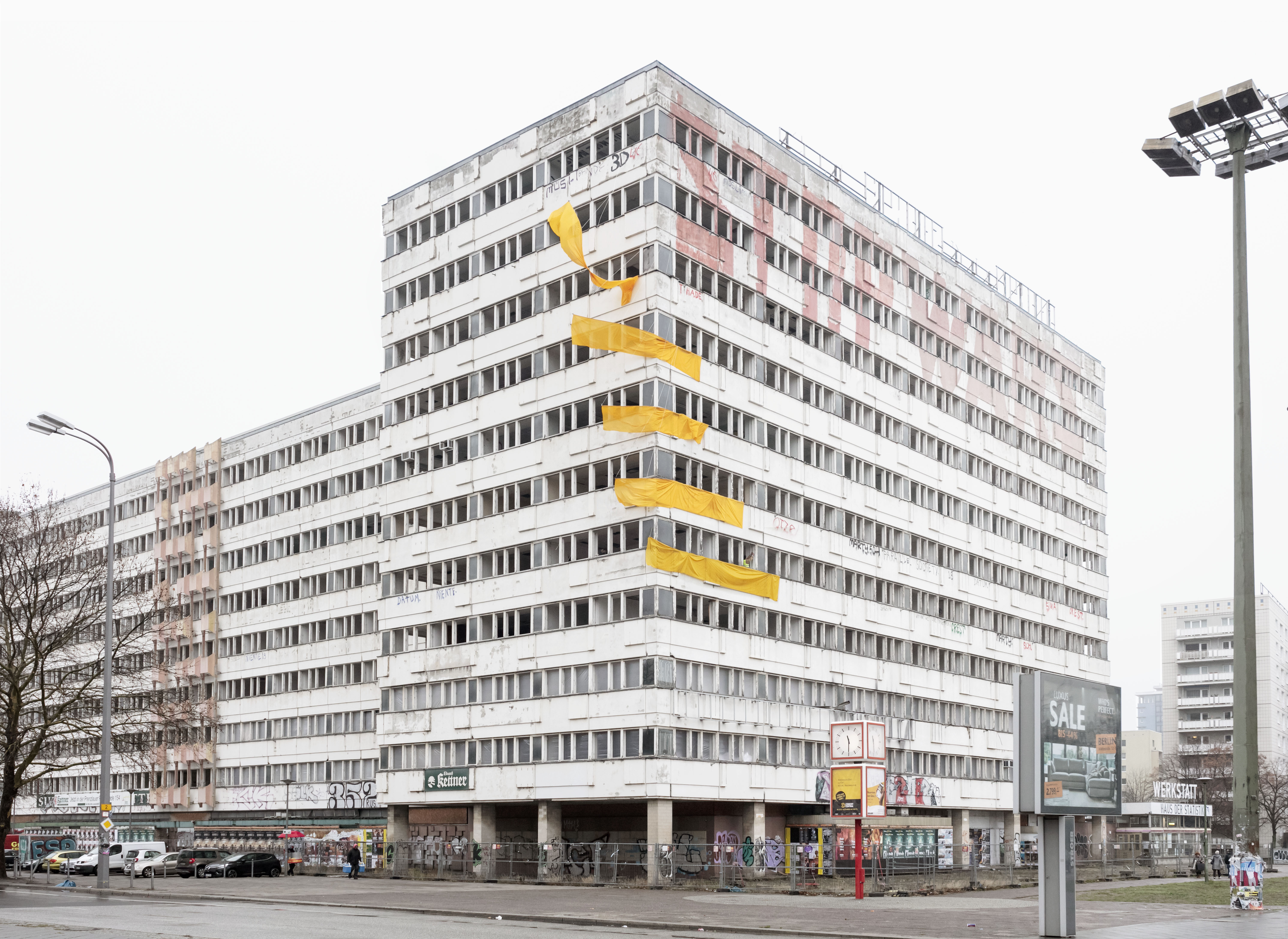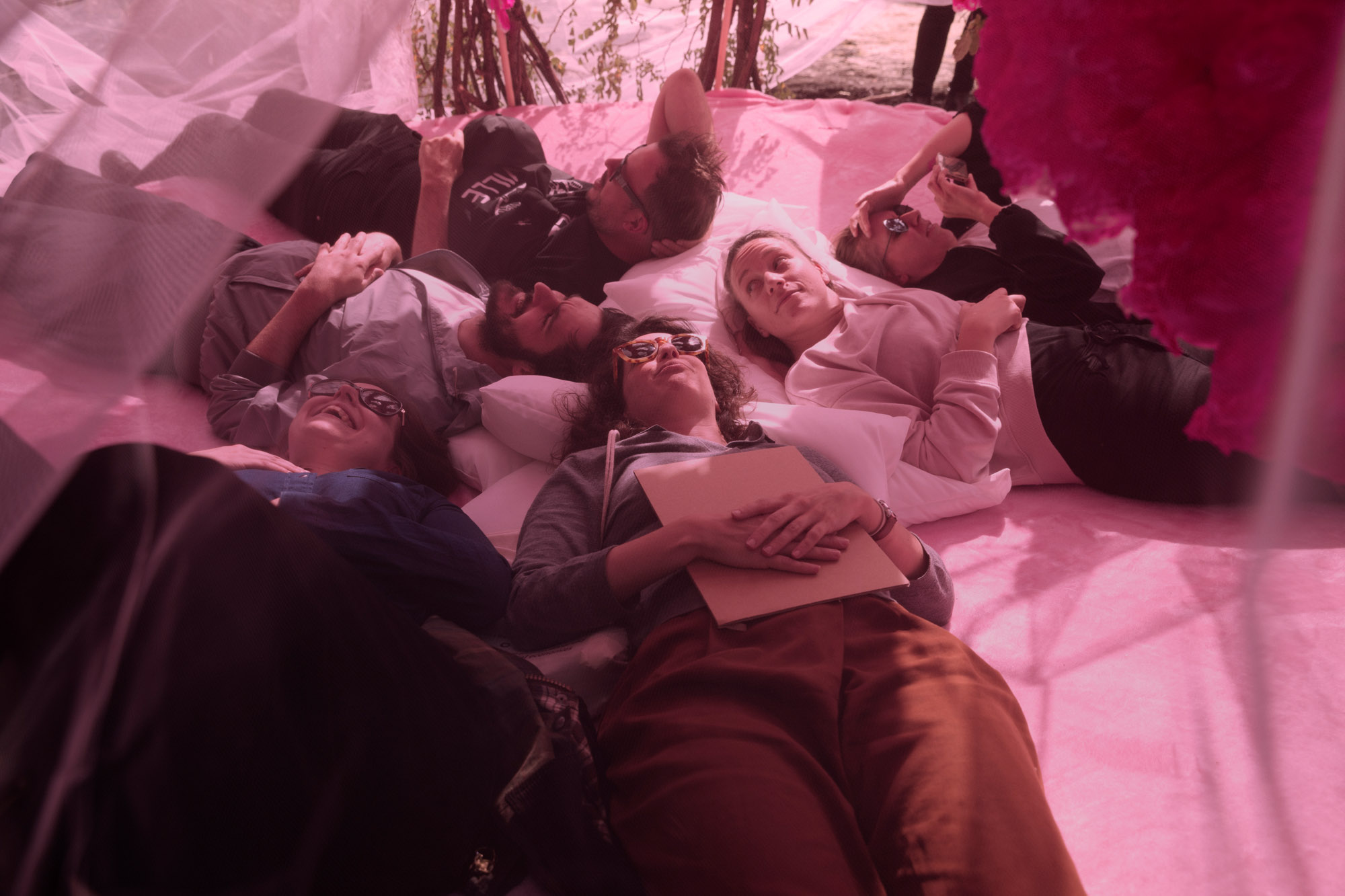Valentina Karga: Energies in Common
by Tessa Zettel
It was some months before I realised that ‘banana-mami’ was in fact ‘banana mummy’. Valentina had been talking about the energetic powers of pyramids for a while, building and testing them for herself, placing ordinary bananas in their centres to see if they lasted any longer than they would on the kitchen bench (they tended not to). I imagined banana-mami to be like some kind of magically transformative sixth taste, a quality transmitted through air, bodies and structures that derived simultaneously from the most mundane and esoteric of sources. It was somehow disappointing to discover that the words referred, rather more pragmatically, to an unusually well-preserved fruit. But pragmatism in Valentina Karga’s work is anything but dull, and her elusive banana mummy is the emissary of a new body of critical and conceptually rich multi-disciplinary investigations into how energy is produced, understood and circulated through contemporary worlds. This research is due to find its audience in the artist’s first ever solo show at Helsinki’s Hippolyte gallery in 2019, the outcome of a two-month residency at Finland’s Saari Residence last winter. I was fortunate to visit Valentina in that frosty wonderland, helping to cook pancakes on a temporary brick rocket stove in the snow as part of her ongoing Hot Stuff project (2017–ongoing), and continuing a conversation about autonomy and radical interdependence that began many summers ago in a backyard micro-farm in Berlin.
Since we met in the thick of her first experiment in urban self-sufficiency, 30 Days in the Garden (2012), Valentina’s work has shifted form and mode many times, following threads of theoretical enquiry across diverse contexts and platforms. Born in the Greek island of Chalkidiki and trained as an architect in Thessaloniki, she came to Berlin in 2010 to be part of the Universität der Kunste Graduate program. There she found herself working between the fields of architecture, biology, design, agriculture and sculpture to devise what she now terms ‘simulations’, small-scale, self-built scenarios offering people the opportunity to think differently through macro paradigms like food, education, housing, neighbourhood, city – via collaborative, hands-on processes of doing, making, learning and talking, that fed back through research blogs, events and publications. In Summer School for Applied Autonomy (2013), an off-grid, closed-loop DIY living module resembling a kind of lo-fi/sci-fi campsite, rotating residents needing no special expertise gleaned their information, skills and resources (including any foods they could not grow onsite) from guests, Youtube videos and each other. Certainly a week in residence left my cohabiter and I acutely aware of our limits and potential in the ‘life skills’ department. Tiny potatoes grown in dry raised beds took hours to half-bake in a solar oven; trade negotiations with German-speaking neighbours were alternately frustrating and uplifting. What the artist provided here was a soft social and material infrastructure inviting participants to cultivate their own (shared) capabilities, something akin to feminist thinker and historian of science Donna Haraway’s concept of ‘response-ability’.
In a broader schema, those abilities are profoundly relational, to go beyond the bubble they depend upon a first-hand familiarity with the systems currently producing and maintaining dominant lifeworlds. Turning her attention to the background scaffolding that supports (or not) such an artist choosing to ‘live and work in Berlin’ but outside the traditional art market, Valentina then began to model hacks of economic systems instead. Market for Immaterial Value (2015–ongoing), a collaboration with Pieterjan Grandry, is a hydra-like research platform picking at the nexus of labour, speculation, production, finance and value that underpins and delimits the parameters and operations of art practice, if not every facet of contemporary life under late liberalism. Initial funding from the Vilém Flusser Residency Programme for Artistic Research/transmediale facilitated a series of conversations and interviews published as an open source blog, a prototype artist-led financial instrument (designed to propel the project further) and even a line of T-shirts, that made space for demystifying the magic of capitalist-neoliberal economics, and thinking/doing together based on other paradigms of value and exchange. Perhaps its most curious output has been The Gigantic Jelly-Blob, a recurring participatory lecture-performance that turns audiences into co-creators of a new narrative addressing the full-scale immersion of our inner psyches in digital and finance capitalism. From Athens to Moscow, participants have enacted specific roles within a discursive rolling lecture on ‘the jelly’, using fiction and metaphor as a device to embody and exchange ideas around the persistent drive to escape into dualities or other forms of separation, and the possibilities for collective cosmic unity.
In the video Our Coming Community (2016), made with residents of a suburban Helsinki neighbourhood, Valentina stands before a swirling cosmic earth and observes gravely, but with a twinkle in her eye, that ‘the world as we know it exists only in our minds’. Underlying all her work is a deep commitment to the power we already have to change everything, including frameworks and institutions, since what we call reality is just a commonly agreed upon ‘set of psychic, social and philosophical protocols’, a shared fiction that nevertheless goes on to have very real material consequences. Her latest iteration of this project, Coming Community (2018), is a site-specific installation on the island of Koh Klang made for the inaugural Thailand Biennale. As before, the artist held workshops with locals to discuss what values or mindsets they wanted their communities to carry into the future, potential threats, and responses that could strengthen them into new ‘world-bearing structures’. These stories were then translated into symbols stamped on traditional bricks, which together form four tall pillars, one for each village on the island. Such works gesture quite simply at supportive collective structures built from diverse parts, but also stake out a rare moment to reconsider what is taken for granted, asking where exactly are we going, would we rather be headed somewhere else, and could we use some talismanic helper spirits to get us there?
The dynamic energies circulating through Valentina’s work are of course also on their way to and from other places. Working across different collaborative formations, she is embedded in multiple tangled ecologies of resources, skills, knowledge and friendship, actively taking care to share process, output and learning along the way. A recent project with Marjetica Potrč, Food is Energy (2018), leaves behind a pyramidal greenhouse forest garden as an interdisciplinary laboratory at the Agricultural University Athens, accompanied by a manual explaining its production, maintenance, and theoretical premise, and encouraging future adaptations. These are deliberate decisions that reflect a commitment to growing our capacity to learn from and ‘become-with’ those we call others in environments rapidly breaking apart, what Anna Tsing has termed ‘arts of living on a damaged planet’. Collective Disaster, of which Valentina Is a co-founder, is another group venture assembling a shifting network of diverse practitioners precisely to build up such collective response-ability. In works like Temple of Holy Shit (2014), a Terra preta-producing outdoor dry toilet and community stage, and Miracle Mountain (2016), a sunken pool in the woods heated alchemically by a mound of compost, the collective offers experimental public infrastructures that enable other ways of living. Architectures like this are what Potrč would call relational objects, empowering participants to change their realities but also building capacities and shared resources – commons of many kinds – within and across networks of makers and thinkers to make us all stronger and more capable. The urgent question of ‘what might we be capable of together?’, framed by philosopher Vinciane Despret and zoologist Michel Mueret elsewhere in terms of ‘cosmoecology’, is something I look forward to Valentina’s work continuing to probe, threading together the concrete and the mystical with humour and care, far into the coming horizon.
Valentina Karga is a greek artist and professor for the initiation of artistic work in Design at HFBK Hamburg. She will be part of the Making Futures School, working together with Dubravka Sekulic, Elise Hunchuck and Jonathan Solomon on the Education Track.
____
This text was originally published at Lechernfeld Nr.45, October 2018, Hochschule für bildende Künste Hamburg. We want to thank its author Tessa Zettel for allowing us to republish it here.
Notes
(1) Vinciane Despret and Michel Meuret (2016), ‘Cosmoecological Sheep and the Arts of Living on a Damaged Planet’, in Environmental Humanities, Vol. 8. Iss. 1





